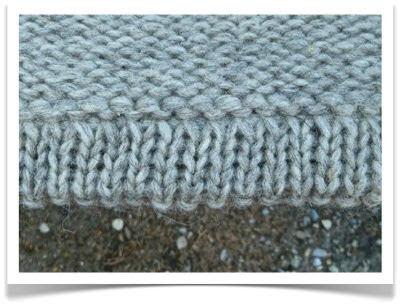Last week I showed you some pictures of a custom Cowachin sweater I made. It was requested that the cuffs and bottom edge be hemmed, rather than working them in ribbing. This is how I did it:
A big concern was the thickness of the yarn. With a typical sweater, the thickness of yarn used in a Cowachin sweater would be knit on 10mm (15US) needles. For a traditional Cowachin sweater, this same yarn is knit with 7.5-8mm (11US, and there is no equivalent for the 7.5mm is US needle sizing) needles for the main body. So, you can see that it is worked up with a very dense fabric. Doubling that fabric in a hem was no going to work. This was dealt with by thinning the yarn used in the fold-up portion of the hem. Typically, the yarn for these sweaters comes in a 5-6 ply, which has not been spun. To thin the fold-up portion, I just peeled off 3 plies as I knit, so that I was knitting with only 2 plies (I was using Briggs and Little Country Roving, which is a 5 ply).
Using the larger of the two recommended needle sizes in you pattern, cast on the required number of stitches using just 2 plies. Work 5 rows of Stocking Stitch, starting and ending with knit rows.
Now, re-incorporate the missing plies to bring the thickness back up to that of the original yarn (5 or 6 plies, depending on the yarn used). Next, knit one row on the wrong side of your work, using the full thickness of yarn. This will create the fold line, seem in the centre of the above photo. Continuing to work with all plies, work 6 rows of Stocking Stitch, starting with a knit row. The fabric hanging from your needle should look like that pictured above.
The hem connecting row comes next.
Hold the bottom edge of your fabric, and look for the loops created by your cast on. In the photo, the loops have been pulled out a bit to make them more visible. I used a Backward Loop Cast On for this particular project, in order to get more visible, easy to find loops. But, this technique is possible with any standard cast on.
Insert your right-hand needle into the first stitch on the left-hand needle, then the very first loop of the cast-on edge. (NOTE: It is important to be sure you have the actual first loop, or you will run short at the end of row) Now, knit the stitch and the loop together. This will start to connect the fold-up portion of the hem to the body of the sweater. Insert the right-hand needle into the next stitch in line on the left-hand needle, and pick up the next cast-on loop, knitting the two together. Continue across the row in this manner, until hem in totally connected and the row is complete.
This is a wrong side view of the finished hem. The only thing left to do is to knit enough rows in Stocking Stitch to reach the same depth as the ribbing in the original pattern. This will depend on the specific instructions in the pattern you are using. At this point, you would just start following the charted portion of your instructions.
Knit the back, both fronts, and both sleeves in this manner. Knit collar, as in instructions, and sew together as usual. The end result will be a traditional Cowachin sweater, with a bomber jacket feel.









